Firearms and Violent Deaths
1 Nov 2016
By Mireille Widmer and Irene Pavesi for Small Arms Survey
This article was external pageoriginally publishedcall_made by the external pageSmall Arms Surveycall_made in October 2016.
The 2030 Agenda for Sustainable Development explicitly links firearms, violence, and sustainable development (UNGA, 2015). Sustainable Development Goal (SDG) 16 includes global commitments to significantly reduce ‘all forms of violence and related death rates’ (Target 16.1) as well as illicit arms flows (Target 16.4) by 2030. In addition, the Inter-Agency and Expert Group on SDG Indicators recommends that states provide data on violence-related deaths disaggregated by instrument of violence, among other factors (IAEG–SDG, 2016, p. 6).
Measures that target the use, possession, and transfer of firearms—such as dedicated legislation, transfer controls, amnesties, or crackdowns on illicit possession—can help to reduce violent deaths in both conflict and non-conflict settings.1 Such measures can also assist in curbing non-lethal outcomes, such as the rate of firearm-related injuries, disability, and psychological trauma, on which comprehensive national data is scarce (Alvazzi del Frate and De Martino, 2013).
This Research Note analyses trends in firearm-related violent deaths. It presents estimates based on data in the Small Arms Survey’s database on violent deaths, which currently covers countries around the world from 2004 to 1 August 2016 and includes both conflict deaths and homicide data sets (Small Arms Survey, n.d.; see Box 1). The Note updates data published in the Global Burden of Armed Violence 2015 (Geneva Declaration Secretariat, 2015a). It finds that:
- Globally, firearms were used in an estimated 46 per cent of all violent deaths in 2010–15. Specifically, they were used in 50 per cent of homicides and 32 per cent of conflict deaths.
- The use of firearms in lethal violence is particularly prevalent in the Americas, as well as Southern Africa and Southern Europe. In most regions, the proportion of violent deaths that involved firearms was fairly stable from 2007–12 to 2010–15, although averages decreased in the Caribbean and increased in Southern Africa.
- National time-series data reveals differing patterns in Albania and Croatia. In Albania, firearm and non-firearm violent deaths have risen and fallen in parallel, suggesting that they are both influenced by common factors. In Croatia, the rate of firearm homicide decreased by 70 per cent between 2006 and 2013, independently of the rate of non-firearm homicide, which remained relatively stable.
- Efforts are required to improve the availability and quality of data on firearm deaths, particularly in Africa, Asia, and Oceania.
Box 1 Methodology
‘Violent deaths’ is a composite indicator combining data on lethal violence in conflict and non-conflict settings. This Research Note does not consider firearm-related suicide, unintentional violence, or killings in the context of legal interventions.
The Small Arms Survey tracks conflict mortality data—including all direct conflict deaths—for 36 countries and territories that are experiencing or have experienced armed conflict since 2004. Data on conflict deaths disaggregated by instrument is consistently available for Iraq and Syria, and sporadically for Afghanistan and Ukraine.
Non-conflict violent deaths are monitored in 221 countries and territories. For 64 of them, half of which are in Africa, only rough estimates are available. For each of the remaining 157 countries and territories, a single source of information on violent deaths was selected on the basis of the following criteria: length of the time series, clarity, consistency, and accessibility.2 Comparisons of data on violent deaths and violent deaths by firearm should be made with caution, as their sources differ for some countries. For the period 2010–15, homicide data disaggregated by instrument was available for only 70 countries, mostly in Europe and the Americas, down from 90 for 2007–12.
Details from the Small Arms Survey’s database on violent deaths—including violent death rates for 2004–15 and disaggregated averages for 2010–15—are accessible online at:
http://www.smallarmssurvey.org/tools/interactive-map-charts-on-armed-violence.html
For a discussion of the challenges related to the collection of data on violent deaths, see Small Arms Survey (2015).
Firearms and violent deaths in 2010–15
Between 2010 and 2015, an estimated 46 per cent of violent deaths—214,000 per year on average—resulted from the use of firearms around the world (Small Arms Survey, n.d.).
Specifically, they were used in 50 per cent of homicides and 32 per cent of conflict deaths. As shown in Figure 1, the use of firearms was particularly prevalent in the Americas (Central America, the Caribbean, and South and Northern America), as well as in Southern Africa and Southern Europe. Due to a dearth of data for some countries that are disproportionately affected by armed conflict, this analysis excludes certain sub-regions.
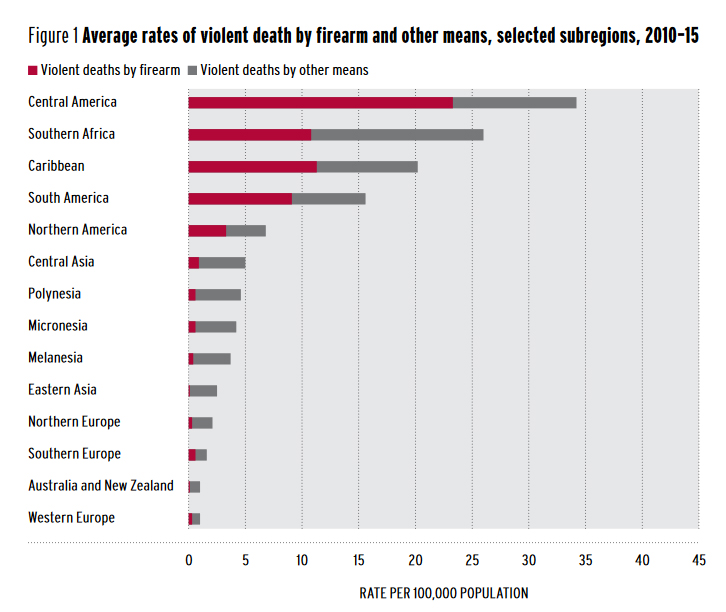
This data is fairly similar to previously published figures for 2007–12 (Geneva Declaration Secretariat, 2015a, p. 75), although the proportion of fire-arm homicides increased in Southern Africa and decreased in the Caribbean. In comparison, Northern America and Southern Europe exhibit much lower rates of violent deaths, but the use of firearms in violent deaths, as opposed to other instruments, is also relatively high.
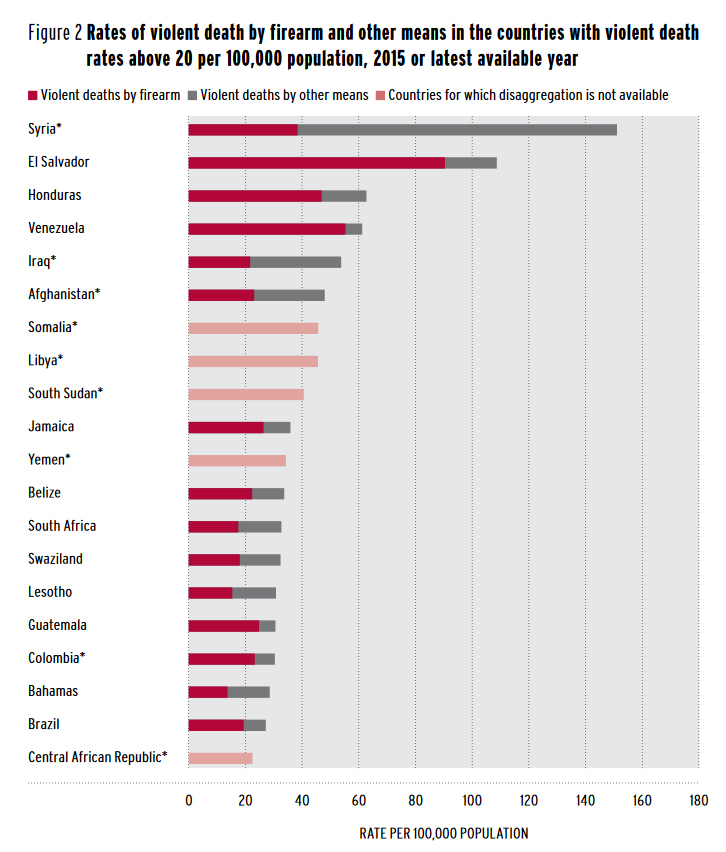
Figure 2 shows, wherever available, the proportion of firearm-related deaths in the 20 countries that registered the highest violent death rates in 2015, or in the latest year for which data is available (Widmer and Pavesi, 2016). The proportion of firearm deaths is high in most of the 20 countries. Most of the countries that were not affected by conflict are located in the Americas; just under half (nine) of the countries were emerging from or experiencing armed conflict.
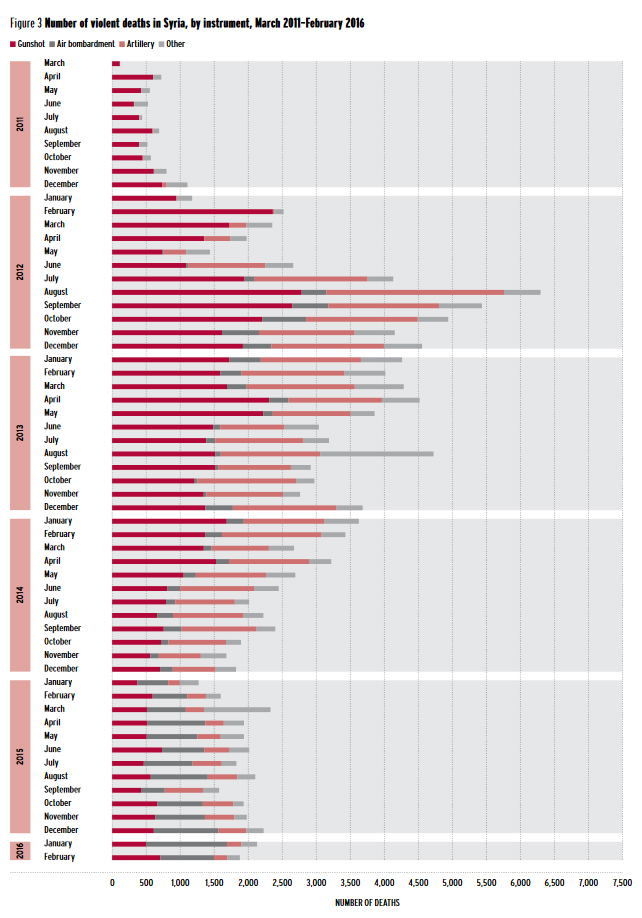
The proportion of firearm deaths varies across conflict-affected countries, as well as over time in a single conflict. Such fluctuations reflect changes in the intensity or type of warfare. In Syria, for example, fire-arms accounted for about 80 per cent of fatalities in the early months of the war, between March 2011 and January 2012, when overall fatalities remained well below 2,000 people per month (see Figure 3). As the war intensified, in mid-2012, artillery use increased and the proportion of deaths by gunshot dropped below 50 per cent. In the second half of 2012, and particularly from 2015, air bombardments also increased. From January 2015, the annual share of fatal gunshots dropped below 30 per cent of total fatalities, with air bombardments often claiming more lives than either small arms or artillery. Firearms can account for a significant proportion of violent deaths regardless of a country’s overall violent death rate. Figure 4 shows 19 countries that are not affected by armed conflict, have a population of more than 100,000, and registered that at least 50 per cent of violent killings were committed with firearms in 2015 or the latest available year. In these countries, violence reduction programming clearly needs to address the role of firearms.
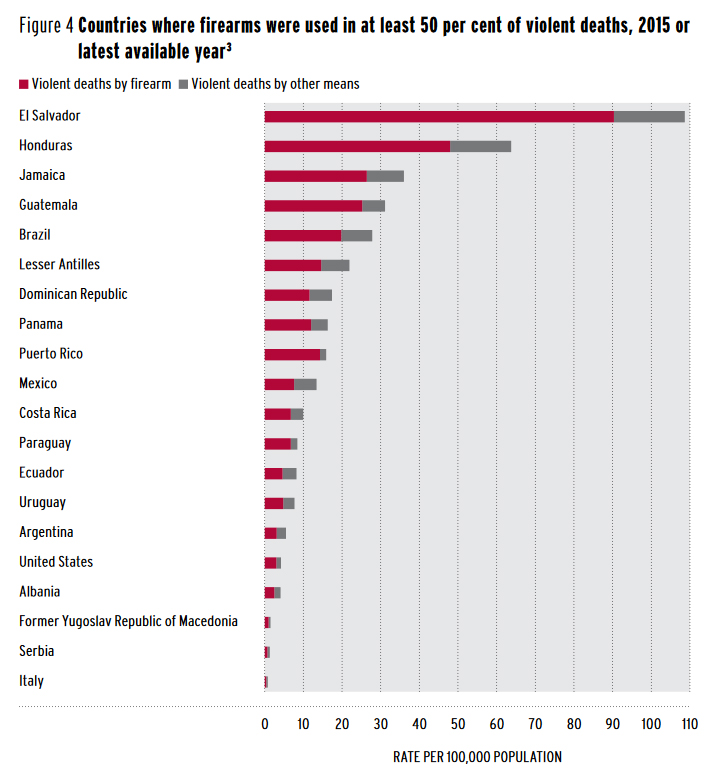
Reflecting regional trends, 14 of these countries are located in Latin America and the Caribbean. In the Americas—unlike in other regions—the percentage of violent deaths by firearm is linked to the total violent death rate. That is, the higher a country’s violent death rate, the greater the proportion of firearm deaths within this total tends to be. Yet the proportion of firearm deaths is actually highest for countries with low violent death rates (fewer than 10 per 100,000 population). A case in point is the United States, where almost 70 per cent of violent deaths were caused by fire-arms in 2010–15, although the total violent death rate was 4.5 per 100,000 (see Figure 4).
Another four countries in Figure 4 are in Southern Europe. Three of them are in the Western Balkans, whose firearm death rates are examined in the next section.
Firearm homicide in the Western Balkans
Figure 5 shows sex-disaggregated fire-arm homicide statistics for the Western Balkans.4 As noted above, while overall levels of lethal violence in Southern Europe are relatively low, a high proportion involves firearms. Albania has Europe’s second-highest firearm homicide rate,5 which is closely followed by Montenegro’s, although it is important to note that there have been very few cases of homicide in Montenegro in 2012, the latest year for which disaggregated data is available. In addition, in Montenegro and the former Yugoslav Republic of Macedonia (hereafter Macedonia), a relatively high proportion of female homicide victims are killed by firearm.6
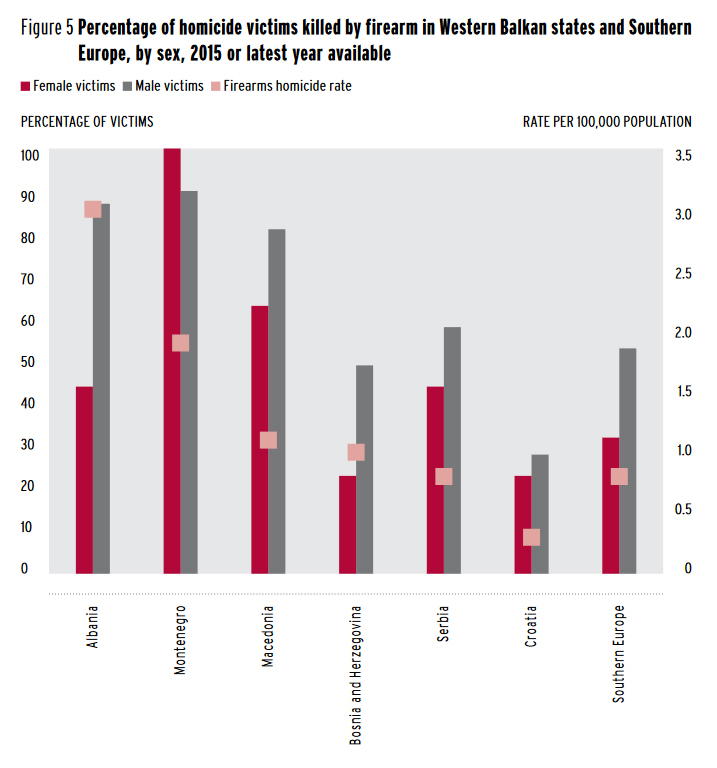
Figure 6 shows multi-year trends for the four Western Balkan countries for which time-series data is available, namely Albania, Croatia, Macedonia, and Serbia.
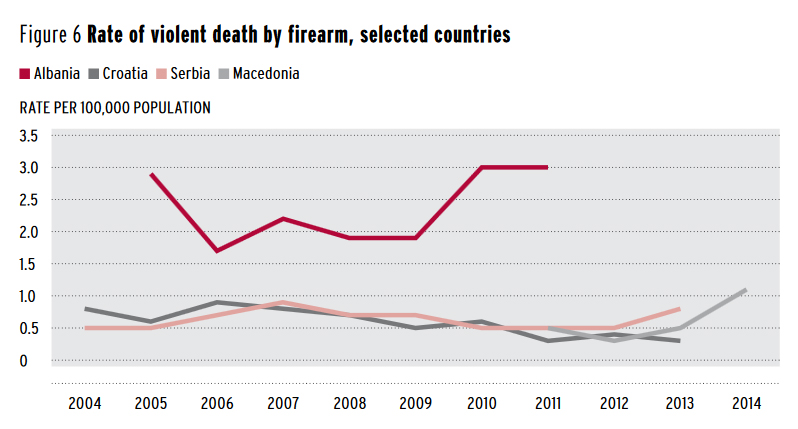
As shown in Figure 7, Albanian rates of firearm and non-firearm homicides rise and fall in parallel (Small Arms Survey, n.d.), suggesting that variations are due to factors that influence both rates. Croatian data reflects a 70 per cent decrease in firearm homicides between 2006 and 2013—in contrast to non-firearm homicides, which remained relatively stable during the same period.

In Croatia, the divergent paths taken by firearm and non-firearm death rates after 2007 correspond to the entry into force of a new Weapons Act, which tightened conditions for weapons acquisition and possession (Croatia, 2007). This legislative reform was followed by two campaigns for the voluntary surrender of weapons, in 2007–09 and 2009–11, and a firearm awareness raising drive involving the Veterans Association, a women’s group, and community youths (Croatia, 2010). By December 2011 some 58,800 small arms, light weapons, and explosives (including more than 7,000 firearms) had been collected; by the end of 2012, more than 33,000 of these weapons had been destroyed (Croatia, 2014; SEESAC, 2011, 2012; UNDP, 2012). While correlation does not prove causation, the relationship warrants further study.7
Conclusion
In pursuing the goal of ‘peaceful and inclusive societies for sustainable development’, UN member states undertook to ‘[s]ignificantly reduce all forms of violence and related death rates’ and ‘illicit [. . .] arms flows’ (UNGA, 2015, Goal 16), reflecting the linkages between lethal (and non-lethal) violence and firearms in many parts of the world.
The regions most affected by firearm violence are the Americas, Southern Africa, and Southern Europe, albeit with significant national—and gendered—variations. National trend analysis reveals diverging patterns for Albania and Croatia. In Albania, rates of firearm and non-firearm homicides have recently moved in step, suggesting that similar factors may influence both. In Croatia, on the other hand, firearm homicide rates have decreased independently of non-firearm homicides, possibly as a result of targeted firearm-related measures. In conflict-affected countries, the proportion of violent deaths involving the use of firearms tends to vary according to the type and intensity of warfare.
A more comprehensive understanding of firearm violence, and of possible responses to it, needs to take account of the motivations behind such violence, the identities of victims and perpetrators and their relationships to one another, the locations where firearm violence is perpetrated, the types and origins of weapons, and the interactions of these parameters with other risk factors. Time-series analysis is also important in evaluating the effectiveness of policies and interventions aimed at curbing firearm violence.
While many questions remain to be answered, the overall availability of quality data on firearm deaths is poor and, in certain regions, declining. These trends run counter to the ‘data revolution’ called for by the 2030 Agenda in all of the areas covered by the Sustainable Development Goals, but they can be reversed.
Notes
1 For more information and examples of measures, see ISACS (2012; 2015) and Wilson (2014).
2 For a list of data sources, see Geneva Declaration Secretariat (2015b).
3 Countries in this selection meet the following five criteria: (1) the population exceeded 100,000 people; (2) disaggregated data is available; (3) there was no armed conflict; (4) at least 50 per cent of violent deaths were committed with fire-arms; and (5) at least 20 firearm homicides were registered.
4 The Western Balkans comprise Albania, Bosnia and Herzegovina, Croatia, the former Yugoslav Republic of Macedonia, Kosovo,* Montenegro, and Serbia. For more information on firearms and armed violence in the region, see Carapic (2014).* The designation of Kosovo is without prejudice to positions on status and is in line with UN Security Council Resolution 1244 and the International Court of Justice Opinion on the Kosovo declaration of independence.
5 Only the Russian Federation has a higher firearm homicide rate: an average of 3.8 per 100,000 in 2010–15 (Small Arms Survey, n.d.). For a discussion of gun crime in Albania, see Davies (2016).
6 A forthcoming Research Note will explore the gendered dimensions of violent deaths.
7 Future research could usefully consider the fact that Croatia had already implemented a similar programme to enhance security through the voluntary surrender of firearms, ammunition, and explosives in 2001 (Grillot, 2010, p. 155) and the country’s membership in NATO (as of 2009) and the European Union (as of 2013). For an epidemiological review of the link between firearm legislation and firearm-related injuries, see Santaella-Tenorio et al. (2016)
About the Authors
Mireille Widmer is a community and urban safety specialist with 15 years of experience in project implementation, policy development and research. Irene Pavesi is a researcher at the Small Arms Survey.
For more information on issues and events that shape our world, please visit the CSS Blog Network or browse our Digital Library.

